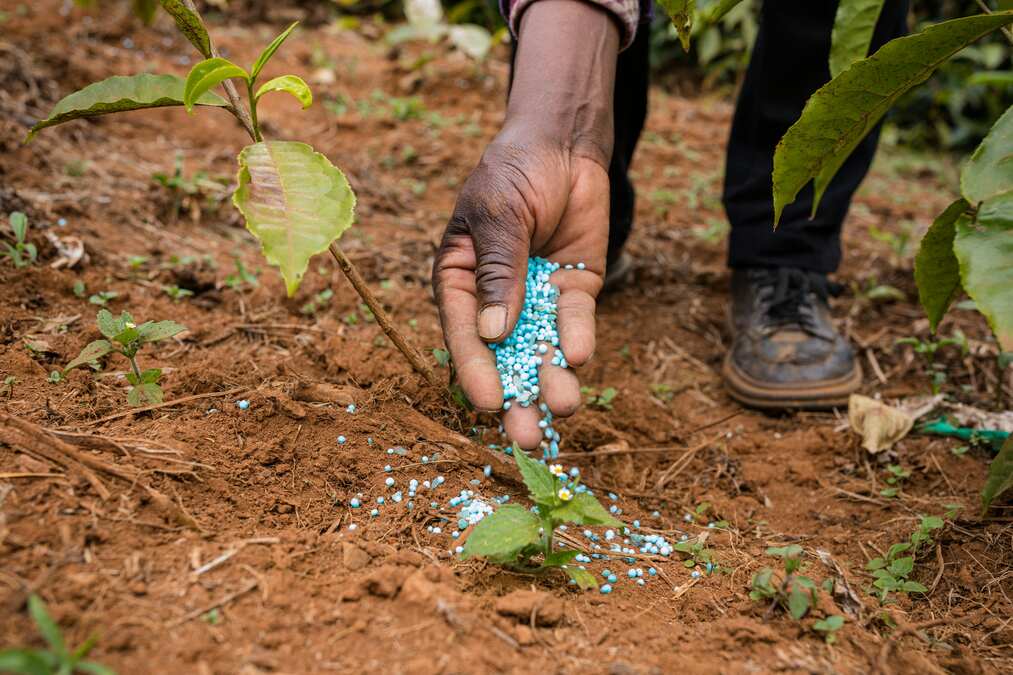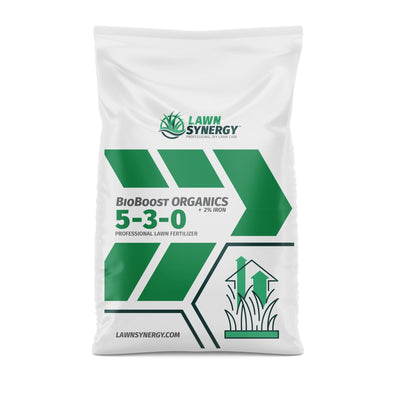Welcome to Lawn Synergy, where our green thumb backs every grain of advice! If you're wondering what the best new lawn fertilizer on the market is, we've got you covered.
After exhaustive testing and real-world triumphs, we've refined our approach to what we confidently call the best new lawn fertilizer.
In this article, we'll dive into everything you need to know about starter fertilizer. We'll discuss what starter fertilizer is, why it's essential for new grass, and provide a step-by-step guide on how to fertilize new grass effectively.
What this article covers:
- What Is Starter Fertilizer?
- Why Is Starter Fertilizer Necessary for New Grass?
- How to Fertilize New Grass
What Is Starter Fertilizer?
Starter fertilizer is a specialized blend designed to provide a nutrient-rich foundation essential for new lawns. This type of fertilizer typically features a balanced mix of nitrogen, phosphorus, and potassium, with a higher concentration of phosphorus to promote strong root development.
At Lawn Synergy, we've developed our own starter fertilizer from our collection of lawn fertilizer. Introducing the Starter Fertilizer 15-20-10, designed to kickstart your lawn's growth and nurture it to its full potential.
By choosing our products, you're not just feeding your lawn; you're setting it up for long-term success.
Why Is Starter Fertilizer Necessary for New Grass?
From our experience, new grass needs more phosphorus compared to nitrogen and potassium. Phosphorus encourages strong root development, which is vital in the early stages of lawn establishment. Without it, new grass struggles to thrive in its new environment.
Phosphorus is one of the three primary macronutrients essential for plant health. It plays a critical role in the energy transfer process, helping young grass to develop a robust root system that can efficiently absorb water and nutrients.
This foundational growth sets the stage for a healthy, resilient lawn. Without adequate phosphorus, new grass seedlings often show stunted growth and weak root systems, making them more susceptible to disease and environmental stress.
Starter fertilizer is formulated to provide a higher concentration of phosphorus to meet these specific needs of new grass.
How to Fertilize New Grass
In this next section, let's delve into how to effectively fertilize new grass, ensuring your lawn gets the optimal start. Proper fertilization is crucial, and selecting the right product is the first step. We recommend using the best lawn fertilizer available that matches the specific needs of your soil and climate.
1: Prepare Your Soil
First, ensure your soil is ready to support new growth. This involves breaking up the soil, removing weeds, and ensuring it's not compact.
Start by tilling or digging the soil to a depth of about 6-8 inches, which helps to aerate the soil and provide a loose, friable texture for roots to penetrate easily. It's crucial to remove any rocks, debris, and old plant material to create a clean bed for your new grass.
Next, address the soil's nutrient content. Incorporate organic matter such as compost or aged manure to enrich the soil and improve its structure. Adding organic matter increases the soil's ability to retain moisture and nutrients, which is essential for the healthy establishment of new grass.
Aim for a layer of about 2-3 inches of compost spread evenly across the surface and mixed into the top few inches of soil.
Additionally, test your soil's pH level to ensure it falls within the optimal range for grass growth, typically between 6.0 and 7.0.
Lastly, level the soil surface to prevent water pooling and ensure even seed distribution. A well-prepared soil bed is the foundation of a successful lawn, providing the ideal conditions for your grass to grow strong and healthy.
By taking these steps, you set the stage for a lush, vibrant lawn that will be the envy of your neighborhood.

2: Get Your Lawn Starter Fertilizer
Choose a starter fertilizer that promises not only to feed your new grass but also to protect it from common pests and diseases. The right starter fertilizer provides essential nutrients to young grass, ensuring it develops strong roots and vibrant green blades.
We've found that the best organic fertilizer for lawn care is one that supports sustainable growth without harsh chemicals, creating a safe environment for your family and pets.
We recommend our Starter Fertilizer 15-20-10 Plus Iron. This formulation is specifically designed to give your new lawn the best possible start. With a nutrient ratio of 15% nitrogen, 20% phosphorus, and 10% potassium, it offers a balanced diet for young grass.
3: Spread Evenly
Even distribution is key to avoid burning new grass. An uneven application can lead to patchy growth and can potentially harm your lawn by causing nutrient overload in some areas while starving others. To achieve optimal results, it's crucial to use a broadcast spreader.
This type of spreader ensures that every square inch of your lawn gets its share of nutrients by scattering fertilizer in a wide, even swath.When using a broadcast spreader, start by calibrating it according to the manufacturer's instructions to ensure the correct amount of fertilizer is being distributed.
Begin spreading along the longest edge of your lawn to create a straight path, and then work in overlapping rows to cover the entire area. Overlapping helps to avoid missed spots and ensures a more uniform distribution of the fertilizer.
For best results, walk at a steady pace, and avoid making sharp turns or stopping abruptly, as this can cause clumping or uneven application. Additionally, consider spreading the fertilizer in two perpendicular passes to further enhance even coverage.
This technique helps to mitigate any potential inconsistencies in spreader performance.
Apply starter fertilizer at the rate of 4-5lbs. per 1,000 sqft.

4: Lay The Grass Seed
After fertilizing, it's time to lay down your grass seed. Selecting the right grass seed is crucial for ensuring a healthy, lush lawn. Choose a seed variety that matches your climate and soil type for the best results.
Begin by evenly spreading the grass seed over the prepared soil using a broadcast spreader to ensure uniform coverage. This helps to avoid bare spots and ensures that each seed has enough space to grow. For smaller areas, you can also spread the seed by hand, but be sure to do so carefully to maintain even distribution.
Once the seed is spread, lightly rake the soil to mix the seeds into the top 1/4 inch of soil. This helps protect the seeds from being washed away or eaten by birds. After raking, gently press the seeds into the soil using a lawn roller or by simply walking over the area. This ensures good seed-to-soil contact, which is essential for germination.
New lawns should be seeded at the rate of 10 lbs seed per 1,000 sqft. Overseeding should be seeded at the rate of 5lbs. per 1,000 sqft.
Finally, water the area thoroughly, keeping the soil consistently moist until the grass seedlings are well-established. Watering is crucial during this period, as it helps the seeds germinate and develop strong roots.

5: Water
Water your new lawn gently but generously to help the seed and fertilizer work together. This initiates the germination process and is crucial for establishing healthy grass.
Begin by lightly sprinkling the seeded area to keep the top layer of soil consistently moist. It's important to avoid overwatering, which can cause runoff and wash away seeds, but also ensure the soil doesn't dry out, which can hinder germination.
During the first few weeks, water your new lawn 2-3 times a day for short periods, especially in the early morning and late afternoon. This helps the water penetrate the soil without causing pooling on the surface.
As the seeds germinate and young grass begins to sprout, you can gradually reduce the frequency but increase the duration of watering sessions.
This encourages deeper root growth, making the grass more resilient and better able to access nutrients.
Once the grass is established, typically after about 4-6 weeks, you can transition to a regular watering schedule.
At this stage, watering deeply once or twice a week is often sufficient, depending on your climate and soil conditions. Remember to adjust your watering habits based on weather conditions; during hot or dry periods, your lawn may need more frequent hydration.

6: Fertilize Established Grass With Regular Lawn Fertilizer
For ongoing care, switch to a regular lawn fertilizer after your new grass is established. Our Almighty 20-0-10 Fertilizer is best about 6 weeks after the seed has germinated. This transition is essential for maintaining the health and appearance of your lawn over time. Once your grass has grown and developed a strong root system, it will require a balanced supply of nutrients to sustain its vigor and resilience.
Regular fertilization helps to keep your lawn green, thick, and free from weeds and diseases.
We recommend using a fertilizer that is specially formulated for your region to address specific climate and soil conditions.
For example, the best lawn fertilizer for Texas is designed to handle the hot, dry summers and variable soil types found in the region. These fertilizers typically have a higher potassium content to help grass withstand heat and drought.
On the other hand, the best lawn fertilizer for Florida focuses on providing nutrients that support growth in sandy soils and high humidity, ensuring your lawn remains lush and green despite the challenging conditions.
Applying the right fertilizer at the right time is key. Generally, it's best to fertilize your established lawn in early spring and fall, with an additional application during the summer if needed.
Always follow the manufacturer's instructions regarding application rates and frequency to avoid over-fertilization, which can harm your lawn and the environment.

Conclusion
We at Lawn Synergy pride ourselves on bringing you products that transform your lawn. From the moment you prepare your soil and lay your grass seed to the ongoing care of your established lawn, every step is crucial for achieving a lush, green landscape.
Additionally, our best weed and feed for lawns collection offers an effective solution to maintain your lawn's health by controlling weeds while providing essential nutrients.
Ready to take the next step? Let us help you achieve the beautiful, thriving lawn you've always wanted.
If you want to learn more, why not check out these articles below:
- Best Fertilizer for Clay Soil Lawn
- Best Iron Fertilizer for Lawn
- Best Lawn Fertilizer for Sandy Soil
- Best Way to Grow Grass
- Best Weed and Feed for Bermuda Grass
- Best Fertilizer for Yellow Grass
- Best Fertilizer for Bahia Grass
- Best Fertilizer for Tall Fescue Grass
- Best Weed and Feed for St. Augustine Grass
- Best Fertilizer for Centipede Grass in South Carolina
- Best Grass Seed Fertilizer
- Best Fertilizer for Mondo Grass





